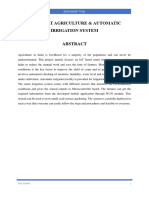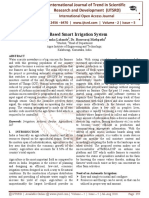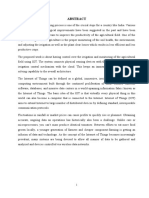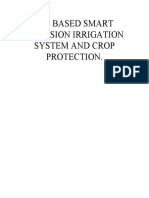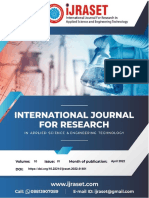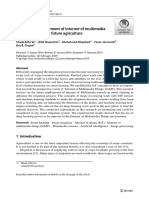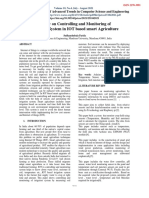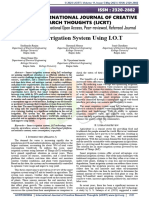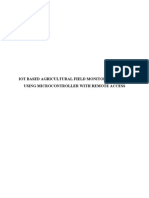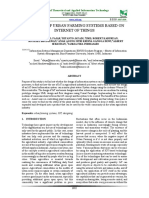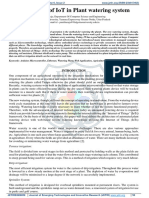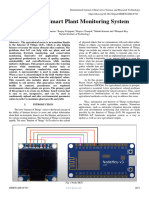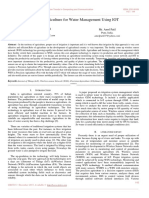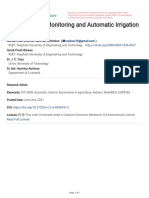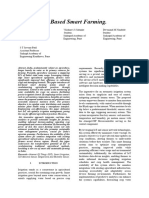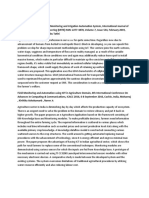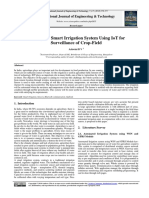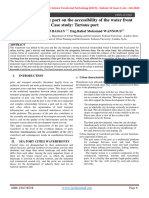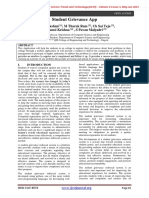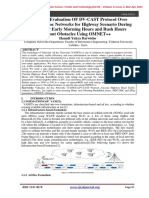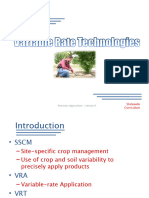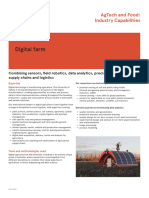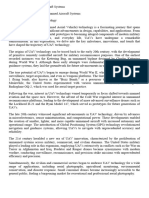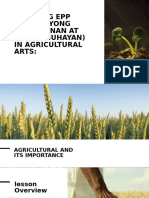(IJCST-V11I6P5) :A.E.E. El-Alfi, M. E. A. Awad, F. A. A. Khalil
(IJCST-V11I6P5) :A.E.E. El-Alfi, M. E. A. Awad, F. A. A. Khalil
Uploaded by
EighthSenseGroupCopyright:
Available Formats
(IJCST-V11I6P5) :A.E.E. El-Alfi, M. E. A. Awad, F. A. A. Khalil
(IJCST-V11I6P5) :A.E.E. El-Alfi, M. E. A. Awad, F. A. A. Khalil
Uploaded by
EighthSenseGroupOriginal Title
Copyright
Available Formats
Share this document
Did you find this document useful?
Is this content inappropriate?
Copyright:
Available Formats
(IJCST-V11I6P5) :A.E.E. El-Alfi, M. E. A. Awad, F. A. A. Khalil
(IJCST-V11I6P5) :A.E.E. El-Alfi, M. E. A. Awad, F. A. A. Khalil
Uploaded by
EighthSenseGroupCopyright:
Available Formats
International Journal of Computer Science Trends and Technology (IJCST) – Volume 11 Issue 6, Nov-Dec 2023
RESEARCH ARTICLE OPEN ACCESS
Web-based smart irrigation system for Lemon plants
A. E. E. El-Alfi [1], M. E. A. Awad [2], F. A. A. Khalil [3]
[1]
Computer Science Department, Mansoura University/ Faculty of Specific Education, Egypt.
[2]
Computer Science Department, Mansoura University/ Faculty of Specific Education, Egypt.
[3]
Computer Science Department, Mansoura University/ Faculty of Specific Education, Egypt.
ABSTRACT
The field of agriculture has been greatly enhanced by the advanced modern technologies. Integrating smart technologies and
devices, the automation process is combined to drive devices to work autonomously and communicate, enabling them to
perform a variety of tasks without the assistance of a human being. Thus, by incorporating some associated electronic devices
and other useful tools frequently used in the field of IoT, this work provides an autonomous irrigation system based on smart
sensors that can be used in a reasonable and economical way to monitor lemons or any type of plants. . . This system includes a
temperature sensor, a water flow sensor connected to the water pump drive valve, and a soil moisture sensor located in the root
zone of the plant.
Keywords: Arduino, GSM, Temperature and Humidity sensor, Soil moisture sensor, Rain sensor
I. INTRODUCTION
Internet of Things is referred to as IoT. It is a network of temperature sensors, and sensors that measure the moisture
real-world items that have been outfitted with sensors, content of the soil, which are placed close to the plants [5].
software, and other technologies in order to connect to other
systems and devices over the internet and exchange data with This paper presents an automated irrigation system, which is a
them. Real-time IoT operates and is soon becoming a reality. mechanism that enables the lemon plant to be irrigated
Since everything is online and becoming increasingly without the need for human intervention. In addition to
intelligent, from smartphones to smart cars, IOT can be monitoring the weather conditions of the plant and making the
witnessed everywhere [1]. appropriate decision.
Using IoT technology, an automated agriculture system is The remaining portions of the essay are structured as follows:
created to monitor and maintain key farming components such Section 2 describes conventional irrigation techniques. The
as soil moisture sensors, humidity sensors, and temperature Smart Irrigation System is discussed in Section 3. Section 4
sensors. The sensors were positioned in the proper locations provides an explanation of related works. The proposed
and positions to sense and transmit the details utilizing cloud system is described in Section 4. Section 6 explains
computing to the farmers' cell phones [2]. applications and outcomes. The conclusion is found in Section
7. Section 8 serves as the paper's conclusion.
Water scarcity is a significant issue that requires farmers to
use IOT technologies to best utilize their water supplies. II. TRADITIONAL IRRAGATION SYSTEMS
Through application-specific heterogeneous sensors, the IoT
offers superior solutions. IoT-based irrigation control systems A traditional irrigation system refers to an irrigation method
assist in reducing water usage in agricultural production via a that has been in use for a very long time, maybe even
variety of means [3]. centuries. Compared to contemporary irrigation techniques,
these approaches are frequently economical, convenient, and
Smart irrigation is a type of irrigation system that uses data environmentally beneficial. It is a method of supplying water
collection and algorithmic analysis to maximize the efficiency to the land by artificial means, such as canals, ditches,
of the water distribution process [4]. sprinklers, or drips. It is used for agriculture and landscaping
purposes, especially in areas or times of low rainfall.
Every drop of water must be conserved; therefore, when a
farmer forgets to turn off the motor, water is wasted. To solve Traditional irrigation systems have been created using surface
this issue, modern technology like IOT has replaced the and groundwater, as well as rainwater harvesting and
conventional method of autonomous irrigation. The motor is utilization.
designed to operate automatically, and its operation is mostly
based on the output of sensors such as moisture sensors, Traditional irrigation systems have several advantages. They
are the best method of irrigation for leveled fields, do not
ISSN: 2347-8578 www.ijcstjournal.org Page 28
International Journal of Computer Science Trends and Technology (IJCST) – Volume 11 Issue 6, Nov-Dec 2023
require any technical knowledge, and are more useful in soils
with less infiltration. In addition, rainwater stays in basins; The mobile of farms can alert him when the soil needs
hence, soil erosion is not caused. Traditional irrigation watering. The farmer or homeowner then sends an SMS
systems require less economic investment, irrigate more area, message to the controller to start irrigation. After receiving an
and provide crops with sufficient water. SMS message from the microcontroller informing him that the
soil is saturated with water, the farmer or homeowner sends
In addition to the advantages of traditional irrigation systems, another SMS message to stop irrigation [10].
there are several challenges that must be taken into account.
For instance, as population grows, so does the need for water F. weather and environment analytics
for home use, hydropower, industry, mining, recreation,
tourism and culture, agriculture, cattle, and fisheries, among Smart irrigation systems can use weather and environmental
other things [6]. data to improve irrigation efficiency. For example, an IoT-
enabled wireless sensor network framework can be used to
III. SMART IRRAIGATION SYSTEM acquire real-time farm information through multi-point
measurement. This can include sensors for soil moisture, soil
Smart irrigation is a system that collects and analyzes temperature, environmental temperature, environmental
physicochemical and climatic data while also providing humidity, CO2 levels, and daylight intensity. A crucial first
irrigation water to the soil. It is an intelligent system that uses step in achieving sustainability and precision in agriculture is
sensors, actuators, water storage units, and nozzles to collect smart weather data management. It serves as a crucial input
weather and soil moisture data, analyze this data, and control for a number of processes, including crop development, yield,
the discharge of irrigation water based on the information and irrigation planning [11].
derived. Intelligent irrigation systems automatically adjust
watering schedules and run times to accommodate various
landscape needs and can significantly reduce water
consumption and preserve the quality of green spaces. A smart
irrigation system should be set up with five main features that
are shown in Fig. 1.
A. Precision agriculture
To increase the sustainability of agricultural production,
precision agriculture is a farming management method
focused on watching, measuring temporal and spatial
variability, and taking action. To maximize input returns while
protecting resources, precision agriculture aims to create a
decision-making tool for overall farm management [7].
Fig.1. Smart Irraigation System [12]
B. Smart schedules IV. RELATED WORK
Irrigation scheduling is the decision of when and how
much water to apply to the field and thus has a direct
effect on water use efficiency [8]. Kanderp Narayan Mishra et. al had stated A brand-new
global network architecture called the Internet of Things (IoT)
offers open services. These days, IoT-based applications are
C. Remote control
widely employed. A wireless sensor network connects the IoT
devices, allowing them to communicate with one another.
Remote control in smart irrigation refers to the ability to Since every gadget is connected to the internet, data may be
control an irrigation system remotely, often through a mobile transmitted between them at any time and from any location
device. Smart controllers reduce outdoor water use by without the need for human interaction. The findings
monitoring and using information about site conditions (such demonstrated the significance of IoT-based applications in all
as soil moisture, rain, wind, slope, soil, plant type, and more) spheres of human endeavour. There are many different kinds
and applying the right amount of water based on those factors of IoT-based applications where IoT strategies are crucial.
[9]. Smart cities, connected cars, smart agriculture, connected
buildings, industry, logistics, and other IoT-based applications
D. Notification system are just a few examples [13].
ISSN: 2347-8578 www.ijcstjournal.org Page 29
International Journal of Computer Science Trends and Technology (IJCST) – Volume 11 Issue 6, Nov-Dec 2023
Yemeserach Mekonnen et. al. had Proposed operate on
distributed wireless sensor technology to schedule precise Through a smartphone application, the user can see the
irrigation events by continuously monitoring and measuring condition of the soil and crops [18].
several environmental factors including soil moisture and
temperature. In order to reduce environmental impact and A I Rokade et. al. had growing interest in proposed green
improve resource management decisions for things like water homes for plant growth is a result of more affordable
and electricity, the system also gathers current meteorological technology that enables farmers to resume output. The
data. The users can obtain the information utilising an easy-to- greenhouse is a transparent building that can control
use mobile application from the local and other databases temperature, moisture, light infiltration, and other factors for
where it has been collected. The smartphone app's purpose is the best possible growth of plants. A method for identifying,
to enable users to remotely view or interact with the farm observing, and responding to environmental changes is known
infrastructure. In order to enable farmers and users to manage as precision agriculture. This method of greenhouse
their farms, the complete system is built with design temperature detection recognises the data and uploads it to the
requirements to be power-efficient, cost-effective, and cloud, after which the agriculturist takes the right action in
minimal maintenance [14]. accordance with the data. This may be seen in the cutting-
edge technology known as the Internet of Things (IoT), which
T Setiaji et. al had stated IoT sensors may provide employs web-based methods to connect any device to the
information on crop condition, smart agriculture is a new internet [19].
concept. IoT links agricultural equipment and gathers data. It
can be used in many different contexts, including the V. THE PROPOSED SYSTEM
connectivity of farms, smart environments, water
management, measuring instruments, crop monitoring, and In this proposed smart irrigation system using IOT, the crop is
other agriculture automation systems. The linked devices have automatically watered by sensing the quantity of soil
the ability to process aggregated data and deliver it to the moisture. The data will be recorded using the sensors. Soil
monitoring center [15]. moisture, rain sensors and GSM Modem are connected to the
Arduino. GSM modem will send the values of soil moisture,
Xuebo Jin et .al. had declared The mobile Internet, cloud temperature, humidity and rain or not to the website. GSM
computing, and Internet of Things are all combined in the modem will send the values of soil moisture, temperature,
smart agriculture system. Massive time series can be acquired humidity and rain or not to the website.
from a variety of sensor nodes and wireless communication The moisture content value is forwarded to the user’s phone.
networks, including environmental temperature , humidity and Based on the content the user will turn on the pump On/Off
soil moisture [16]. .When the moisture content is lower than the threshold value,
the motor is turned ON and it is turned off when the moisture
Fariza Sabrina et .al A hypothetical IoT-based smart
content goes above the threshold value
agriculture scenario is provided to explain how our model
When using this method, irrigation of fields occurs
functions. Data about the environment is gathered by the
automatically. In fields, human intervention is not necessary.
sensors and sent to the IoT gateway. An intelligent controller
The farmer can cut labor costs as a result. By using this
in the cloud is interconnected with the IoT gateway. For real-
method, the fields receive the appropriate amount of water,
time decision-making, the intelligent controller keeps an up-
minimizing the problems brought on by under- and over-
to-date data store. Real-time communication of the decisions
irrigation. There is therefore no chance of crop failure.
enables opportunity for prompt and effective action. However,
An IoT system's fundamental building blocks are sensors,
we want to emphasise that our system is adaptable to include
processors, and applications. The proposed model, which
data from any type and number of sensors, even though the
illustrates how these blocks are connected, is depicted in the
scenario only illustrates two types of sensors [17].
block diagram of Fig.2. Microcontroller and sensors are
Pratik Mohanty et. al. had proposed strong, economical, and connected, and cloud storage is used to display sensor data.
ensuring it needs minimal maintenance. The Internet of The cloud gives users access to continuously collected data
Things is at the centre of the project, allowing for the storing from sensors, enabling farmers to take appropriate action to
of agricultural data in the cloud for eventual use in data meet the requirements of the soil moisture level.
analytics and pattern recognition for new improvements. All
of the data that can be retrieved from the soil is acquired and
transmitted via the sensor nodes. These data are given to the
Sink node, which transforms them into IP packets that can be
transmitted to the cloud. The spectral image is sent to the
cloud on its own by the Multispectral Image Module. The data
is processed by the cloud before being sent to the user.
ISSN: 2347-8578 www.ijcstjournal.org Page 30
International Journal of Computer Science Trends and Technology (IJCST) – Volume 11 Issue 6, Nov-Dec 2023
Fig.3. Arduino UNO
B. Temperature & Humidity
This module includes a DHT11 Temperature &
Humidity Sensor. It features a temperature & humidity
sensor complex with a calibrated digital signal output.
By using the exclusive digital-signal-acquisition
technique and temperature & humidity sensing
technology, it ensures high reliability and excellent
long-term stability.
Fig.4.Temperature & Humidity
C. Soil moisture sensor
A soil moisture sensor can read the amount of moisture
present in the soil surrounding it. It is ideal for monitoring
Fig.2.Block diagram of suggested system garden, or your plant's water level
Proposed system has three main stages:
1. Measurement of sensors.
2. Switch on relay for pumb motor
3. Sending and receiving notifications via web server
and LCD Module. Figure (9) depicts the proposed
system's flowchart.
The smart irrigation system circuit consists of eight
components, as shown in Figure (10).
A. Arduino Uno Fig.5. Soil moisture sensor
The ATmega328P is the core of the Arduino UNO
microcontroller board. It has a USB port, a power jack, an
D. Rain sensor
ICSP header, a 16 MHz ceramic resonator, six analog inputs,
is used for rain detection. It is also for measuring rainfall
fourteen There are six digital input/output pins that may be
intensity. The module includes a rain board and a control
utilized as PWM outputs along with a reset button. all the board that is separate for more convenience.
components required to support the microcontroller is
included; all you need to do to get started is connect it to a
computer, an AC-to-DC adapter, or a battery via a USB cable.
Fig.6. Rain sensor
ISSN: 2347-8578 www.ijcstjournal.org Page 31
International Journal of Computer Science Trends and Technology (IJCST) – Volume 11 Issue 6, Nov-Dec 2023
E. Pump motor F. GSM Modem
A water pump controlled by an Arduino It is an exceptional type of modem that perceives a SIM
microcontroller is a type of system that uses an card and runs on an adaptable overseer enrollment, nearly
Arduino to control the operation of a water pump. The equivalent to a cell phone.
Arduino can be used to turn the pump on and off, as
well as to control the flow rate and direction of the
water. This type of system can be used for various
applications such as irrigation, water treatment, and
industrial process control.
Fig.8.GSM SIM800L Module
Fig.9. Implementation of the suggested system
Fig.7. Pump motor
ISSN: 2347-8578 www.ijcstjournal.org Page 32
International Journal of Computer Science Trends and Technology (IJCST) – Volume 11 Issue 6, Nov-Dec 2023
Fig.10.Flow chart of suggested system
ISSN: 2347-8578 www.ijcstjournal.org Page 33
International Journal of Computer Science Trends and Technology (IJCST) – Volume 11 Issue 6, Nov-Dec 2023
Fig.11.The Schematic for Smart Irragition System
Rules for turn on/ off the pump in the farm VI. APPLICATIONS AND OUTCOMES
According to Fig.11, the rules for opening the pump on/off The primary objective of the suggested system will be to
the farm can be clarified as follows. send the values recorded from temperature, humidity,
soil moisture and rain sensors to the user's web page and
based on the value of soil humidity the pump is turned
Rule on or off.
The tests listed in Table 1 are carried out to determine
If soil moisture sensor value == 0 whether the suggested smart irrigation is effective. The
table clearly shows that when the moisture level is lower,
OR rain sensor value == 0 the motor is turned ON, and when the required moisture
level is reached, the motor is turned OFF.
OR temperature, humidity sensor value > threshold
S. No. Type of soil Moisture Pump
Sound Alarm content (%) ON/OFF
1 Wet soil 80 OFF
Switch on pump
2 Partially Wet soil 50 ON
3 Dry soil 40 ON
send measure data to GSM to display GUI
ELSE
Table1: Performance test on different soils.
Switch off pump
Display measure data LCD Mmodule
End IF
ISSN: 2347-8578 www.ijcstjournal.org Page 34
International Journal of Computer Science Trends and Technology (IJCST) – Volume 11 Issue 6, Nov-Dec 2023
To register a new user or login to the user page by e- mail and
password , as shown in Figure (12).
Fig.15. Graphic representation of soil moisture
Fig.12. Start page to register a new user or login to the user
page if you have already registered
After recording, the user's dashboard shows the values of
humidity, Temperature, soil moisture, rain sensors and a chart
for all values , as shown in Figure (13).
Fig.16. Graphic representation of Temperature
Fig.13. The user's dashboard
Fig.17. Graphic representation of Humidity
Fig.14. Control of water pumping
ISSN: 2347-8578 www.ijcstjournal.org Page 35
International Journal of Computer Science Trends and Technology (IJCST) – Volume 11 Issue 6, Nov-Dec 2023
VII. CONCLUSION [9] Blessy, Angelin, et al. “Sustainable Irrigation
In this paper, it was presented how IoT technology has been Requirement Prediction Using Internet of Things and Transfer
introduced into smart irrigation. By leveraging real-time data Learning.” Sustainability, vol. 15, no. 10, 1 Jan. 2023, p.
and analysis, these systems can help farmers improve water 8260, https://doi.org/10.3390/su15108260. Accessed 8 July
use. The pump can be automatically opened without 2023.
interference from the human element .To irrigate when
needed, thereby saving and not wasting water. [10] Yasin, Hajar M., et al. “Arduino Based Automatic
Irrigation System: Monitoring and SMS Controlling.” IEEE
VIII .REFERENCES Xplore, 1 Apr. 2019
ieeexplore.ieee.org/abstract/document/9019370. Accessed 13
[1] Aaqib Raza, bMuhammad Baqa Khan, cWaqas Ali, Nov. 2021.
dMuhammad Junaid Memon, eRayyan Daudpota," IoT Based
Smart Agriculture Monitoring and Control" , International [11] Keswani, Bright, et al. “Adapting Weather
Journal of Electrical Engineering & Emerging Technology, Conditions Based IoT Enabled Smart Irrigation Technique in
Vol. 04, No. SI 01, Feb 2021. Precision Agriculture Mechanisms.” Neural Computing and
Applications, vol. 31, no. S1, 26 Sept. 2018, pp. 277–292,
[2]Deepa, Bammidi, et al. “Smart Agriculture Using IOT.” https://doi.org/10.1007/s00521-018-3737-1.
Advances in Intelligent Systems and Computing, 11 Aug.
2020, pp. 11–19, 10.1007/978-981-15-5400-1_2. Accessed 2
Feb. 2023.. [12] Nazmul Hassan , et al. “SENSOR BASED SMART
IRRIGATION SYSTEM WITH MONITORING AND
[3] Dr.K.Ramesh 1 Ms. K.Thenmozhi 2 Mr. S.Karthik 3" CONTROLLING USING INTERNET OF THINGS”
IRRIGATION CONTROL SYSTEM IN LEMON FARMING International Journal of Ambient Systems and Applications
BASED ON INTERNET OF THINGS USING (IJASA)Vol 9, Number 1/2 , June 2021
HETEROGENEOUS SENSORS ", Karpagam JCS Vol.13 [ 13] Jin, Xuebo, et al. “A Reversible Automatic Selection
Sep. - Oct. 2019 Normalization (RASN) Deep Network for Predicting in the
Smart Agriculture System.” Agronomy, vol. 12, no. 3, 27 Feb.
[4] Nandanwar, H.; Chauhan, A.; Pahl, D.; Meena, H. (2020). 2022, p. 591
“A Survey of Application of ML and Data Mining Techniques
for Smart Irrigation System.” 2020 Second International [14] Sabrina, Fariza, et al. “An Interpretable Artificial
Conference on Inventive Research in Computing Applications Intelligence Based Smart Agriculture System.” Computers,
(ICIRCA. (Accessed 23 December 2022). Materials & Continua, vol. 72, no. 2, 2022, pp. 3777–3797
[5] Supriya B, KalaiRubin V, Madhuri T G, Spoorthi S, Prof. [15] Setiaji, T, et al. “The Contribution of the Internet of
Soumya C H," IOT Based Remote Smart Irrigation System ", Things and Smart Systems to Agricultural Practices: A
International Journal of Modern Agriculture, Volume 10 Issue Survey.” IOP Conference Series: Materials Science and
2, 2021 Engineering, vol. 1098, no. 5, 1 Mar. 2021, p. 052100
[6] Subhankar Debnath1 , Sirisha Adamala , Mahesh [16] Mohanty, Pratik, et al. “Smart Farming Enabled by IoT
Palakuru(2020)” AN OVERVIEW OF INDIAN and Spectral Imaging.” Journal of Physics: Conference Series,
TRADITIONAL IRRIGATION SYSTEMS FOR vol. 2161, no. 1, 1 Jan. 2022, p. 012044
SUSTAINABLE AGRICULTURAL PRACTICES”
International Journal of Modern Agriculture, Volume 9, No.4, [17] Rokade, A I, et al. “An Autonomous Smart Farming
2020 System for Computational Data Analytics Using IoT.” Journal
of Physics: Conference Series, vol. 2327, no. 1, 1 Aug. 2022,
[7] Precision Agriculture - an Overview | ScienceDirect p. 012019
Topics.” Sciencedirect.com,2016, [17] Mekonnen, Yemeserach, et al. “Review—Machine
www.sciencedirect.com/topics/earth-and-planetary- Learning Techniques in Wireless Sensor Network Based
sciences/precision-agriculture. Precision Agriculture.” Journal of the Electrochemical
Society, vol. 167, no. 3, 2 Jan. 2020, p. 037522
[8] Bwambale, Erion, et al. “Smart Irrigation Monitoring and
Control Strategies for Improving Water Use Efficiency in [19] Mekonnen, Yemeserach, et al. “Review—Machine
Precision Agriculture: A Review.” Agricultural Water Learning Techniques in Wireless Sensor Network
Management, vol. 260, Feb. 2022, p. 107324, Based Precision Agriculture.” Journal of the
https://doi.org/10.1016/j.agwat.2021.107324. Accessed 27 Electrochemical Society, vol. 167, no. 3, 2 Jan. 2020, p.
Dec. 2021 037522
ISSN: 2347-8578 www.ijcstjournal.org Page 36
You might also like
- Metal Detecting Robot CircuitDocument9 pagesMetal Detecting Robot CircuitstarNo ratings yet
- Implementation of IoT Technology in Automation of Irrigation SystemDocument6 pagesImplementation of IoT Technology in Automation of Irrigation SystemInternational Journal of Innovative Science and Research TechnologyNo ratings yet
- Smart IrrigationDocument11 pagesSmart Irrigationrsinchana520No ratings yet
- Smart Irrigation System Based On Soil Moisture Using IotDocument5 pagesSmart Irrigation System Based On Soil Moisture Using IotSureshkumar AlagarsamyNo ratings yet
- E3sconf Iconnect2023 04012Document10 pagesE3sconf Iconnect2023 04012Kimbeng FaithNo ratings yet
- IoT Based Smart Irrigation SystemDocument4 pagesIoT Based Smart Irrigation SystemEditor IJTSRD100% (2)
- Automatic Fertigation SystemDocument12 pagesAutomatic Fertigation SystemIJRASETPublicationsNo ratings yet
- Artificial Intelligent Iot Based Cognitive Hardware For Agricultural Precision AnalysisDocument15 pagesArtificial Intelligent Iot Based Cognitive Hardware For Agricultural Precision AnalysisjoaoeopedejoaoNo ratings yet
- 1 s2.0 S277237552300045X Main - CompressedDocument20 pages1 s2.0 S277237552300045X Main - CompressedRhema DanuNo ratings yet
- Irrigation 2Document3 pagesIrrigation 2zeeshanshukat931No ratings yet
- Arduino Based Automatic Irrigation System Using IotDocument6 pagesArduino Based Automatic Irrigation System Using Iotold flameNo ratings yet
- ReportDocument57 pagesReportNehul Patil100% (1)
- ReportDocument57 pagesReportNehul PatilNo ratings yet
- A12 PaperDocument8 pagesA12 PaperAkshath KandlurNo ratings yet
- Smart Agriculture System Using Iot TechnologyDocument5 pagesSmart Agriculture System Using Iot TechnologyParthasarathy VadapalliNo ratings yet
- 06 Karil06 iJIM Plant Watering Maria Monika SytDocument8 pages06 Karil06 iJIM Plant Watering Maria Monika SytSuyoto UAJYNo ratings yet
- An IoT Low-Cost Smart Farming For Enhancing Irrigation Efficiency of Smallholders FarmersDocument39 pagesAn IoT Low-Cost Smart Farming For Enhancing Irrigation Efficiency of Smallholders Farmerscabean9No ratings yet
- 2023 V14i5012Document6 pages2023 V14i5012babblubabblu295No ratings yet
- Iot Based Smart Precision Irrigation System and Crop ProtectionDocument7 pagesIot Based Smart Precision Irrigation System and Crop ProtectionOlabanjiNo ratings yet
- IJRPR13064Document6 pagesIJRPR13064Gumar YuNo ratings yet
- A Research Paper On Auto Controlling Irrigation System Using Arduino UNODocument8 pagesA Research Paper On Auto Controlling Irrigation System Using Arduino UNOIJRASETPublicationsNo ratings yet
- Neuro-OPS-79 IoT Based Smart Irrigation System Using ArduinoDocument7 pagesNeuro-OPS-79 IoT Based Smart Irrigation System Using ArduinoRikeshNo ratings yet
- An e Cient Employment of Internet of Multimedia Things in Smart and Future AgricultureDocument25 pagesAn e Cient Employment of Internet of Multimedia Things in Smart and Future AgricultureahmedNo ratings yet
- Review On Controlling and Monitoring of Irrigation System in IOT Based Smart AgricultureDocument6 pagesReview On Controlling and Monitoring of Irrigation System in IOT Based Smart AgricultureWARSE JournalsNo ratings yet
- Iot Based Control and Automation of Smart Irrigation SystemDocument7 pagesIot Based Control and Automation of Smart Irrigation SystemRohit RajNo ratings yet
- Ashifuddinmondal2018 PDFDocument5 pagesAshifuddinmondal2018 PDFArpitha GowdaNo ratings yet
- IJCRT2305994Document5 pagesIJCRT2305994qwabsjNo ratings yet
- Water 15 01739Document18 pagesWater 15 01739Houssam zrhallaNo ratings yet
- Automation Irrigation System Using Arduino For Smart Crop Field ProductivityDocument8 pagesAutomation Irrigation System Using Arduino For Smart Crop Field ProductivityIJRES teamNo ratings yet
- SD, MNSD, MFNSDocument5 pagesSD, MNSD, MFNSDemon GamerNo ratings yet
- Mini ProjectDocument58 pagesMini ProjectHarish KhanNo ratings yet
- Iot Based Agricultural Field Monitoring System Using Microcontroller With Remote AccessDocument49 pagesIot Based Agricultural Field Monitoring System Using Microcontroller With Remote AccessAbdul Razzak100% (1)
- 17Vol99No15 PDFDocument10 pages17Vol99No15 PDFAditiya KelanaNo ratings yet
- Smart Irrigation System Using IOTDocument6 pagesSmart Irrigation System Using IOTIJRASETPublicationsNo ratings yet
- Dahane 2020Document6 pagesDahane 2020Avishek JanaNo ratings yet
- Sensor and Cloud Based Smart Irrigation System With Arduino: A Technical ReviewDocument5 pagesSensor and Cloud Based Smart Irrigation System With Arduino: A Technical Reviewattri.gourav1411No ratings yet
- JETIREQ06009Document6 pagesJETIREQ06009sharvbangaleNo ratings yet
- Batch 1Document4 pagesBatch 1ai.praphaNo ratings yet
- IoT Based Smart Plant Monitoring SystemDocument4 pagesIoT Based Smart Plant Monitoring SystemInternational Journal of Innovative Science and Research TechnologyNo ratings yet
- Precision Agriculture For Water Management Using IOT: Mrs. Suvarna J. Patil Mr. Amol PatilDocument3 pagesPrecision Agriculture For Water Management Using IOT: Mrs. Suvarna J. Patil Mr. Amol PatilEditor IJRITCCNo ratings yet
- IOT Based Soil Monitoring and Automatic Irrigation SystemDocument47 pagesIOT Based Soil Monitoring and Automatic Irrigation SystemRuthuja B PNo ratings yet
- Literature ReviewDocument4 pagesLiterature ReviewAbhishek2009GWUNo ratings yet
- Iot Based Irrigation Remote Real-Time Monitoring and Controlling SystemsDocument6 pagesIot Based Irrigation Remote Real-Time Monitoring and Controlling SystemsMuhammad AbubakerNo ratings yet
- IoT Based Irrigation Monitoring SystemDocument5 pagesIoT Based Irrigation Monitoring SystemEngineering and Scientific International JournalNo ratings yet
- A Survey Smart Agriculture IoT With Cloud ComputingDocument8 pagesA Survey Smart Agriculture IoT With Cloud ComputingHariNo ratings yet
- Agricultural Crop Monitoring Using IOTDocument6 pagesAgricultural Crop Monitoring Using IOTJunaidNo ratings yet
- Study of Irrigation System by Using Internet of ThingsDocument3 pagesStudy of Irrigation System by Using Internet of ThingsInternational Journal of Innovative Science and Research TechnologyNo ratings yet
- Iot Based Smart Farming Ieee 22-1Document5 pagesIot Based Smart Farming Ieee 22-1Devanand NandedeNo ratings yet
- Iot Based Smart Farming Ieee 22-1Document5 pagesIot Based Smart Farming Ieee 22-1Devanand NandedeNo ratings yet
- (IJCST-V12I2P7) :devika C.J Nair, Reshma H M, Smrithi B Rajeev, Varsha V, Theertha BDocument4 pages(IJCST-V12I2P7) :devika C.J Nair, Reshma H M, Smrithi B Rajeev, Varsha V, Theertha Beditor1ijcstNo ratings yet
- Literature ReviewDocument2 pagesLiterature ReviewRaji PNo ratings yet
- Design and Implementation of A Cloud-Based Iot Scheme For Precision AgricultureDocument4 pagesDesign and Implementation of A Cloud-Based Iot Scheme For Precision AgricultureHedy PamungkasNo ratings yet
- A Study On Smart Irrigation System Using IoT For SDocument4 pagesA Study On Smart Irrigation System Using IoT For SNiranjan PoojaryNo ratings yet
- A Study On Smart Irrigation System Using IoT For S PDFDocument4 pagesA Study On Smart Irrigation System Using IoT For S PDFMuhammad UsmanNo ratings yet
- (IJCST-V8I6P12) :naveen N, Deepashree R K, Hemashree K, Sirisha V, Kiran Kumar R, Shiva Reddy M VDocument6 pages(IJCST-V8I6P12) :naveen N, Deepashree R K, Hemashree K, Sirisha V, Kiran Kumar R, Shiva Reddy M VEighthSenseGroupNo ratings yet
- A Review On Smart IoT Based FarmingDocument12 pagesA Review On Smart IoT Based FarmingmarchosendaNo ratings yet
- IOT Based Smart Agriculture Monitoring System: Yash Sharma, Vishudeep Tyagi, Priyanka DattaDocument4 pagesIOT Based Smart Agriculture Monitoring System: Yash Sharma, Vishudeep Tyagi, Priyanka DattaNitin ManneNo ratings yet
- IOT Based Smart Irrigation SystemDocument39 pagesIOT Based Smart Irrigation SystemAMRUTHA CITY CYBERNo ratings yet
- Vertikit Conf PaperDocument5 pagesVertikit Conf PaperMariam BakerallyNo ratings yet
- (IJCST-V12I1P2) :DR .Elham Hamed HASSAN, Eng - Rahaf Mohamad WANNOUSDocument11 pages(IJCST-V12I1P2) :DR .Elham Hamed HASSAN, Eng - Rahaf Mohamad WANNOUSEighthSenseGroup100% (1)
- (IJCST-V12I1P7) :tejinder Kaur, Jimmy SinglaDocument26 pages(IJCST-V12I1P7) :tejinder Kaur, Jimmy SinglaEighthSenseGroupNo ratings yet
- (IJCST-V11I4P16) :nikhil Sontakke, Sejal Utekar, Shivansh Rastogi, Shriraj SonawaneDocument7 pages(IJCST-V11I4P16) :nikhil Sontakke, Sejal Utekar, Shivansh Rastogi, Shriraj SonawaneEighthSenseGroupNo ratings yet
- (IJCST-V11I6P4) :sina AhmadiDocument11 pages(IJCST-V11I6P4) :sina AhmadiEighthSenseGroupNo ratings yet
- (IJCST-V11I6P8) :subhadip KumarDocument7 pages(IJCST-V11I6P8) :subhadip KumarEighthSenseGroupNo ratings yet
- (IJCST-V11I4P10) :Dr.N.Satyavathi, Dr.E.BalakrishnaDocument6 pages(IJCST-V11I4P10) :Dr.N.Satyavathi, Dr.E.BalakrishnaEighthSenseGroupNo ratings yet
- (IJCST-V11I4P15) :M. I. Elalami, A. E. Amin, S. A. ElsaghierDocument8 pages(IJCST-V11I4P15) :M. I. Elalami, A. E. Amin, S. A. ElsaghierEighthSenseGroupNo ratings yet
- (IJCST-V11I4P9) :KiranbenV - Patel, Megha R. Dave, Dr. Harshadkumar P. PatelDocument18 pages(IJCST-V11I4P9) :KiranbenV - Patel, Megha R. Dave, Dr. Harshadkumar P. PatelEighthSenseGroupNo ratings yet
- (IJCST-V11I5P3) :sulochana Shejul, Vijay Dhangar, Pravin Dhole, Bharti GawaliDocument8 pages(IJCST-V11I5P3) :sulochana Shejul, Vijay Dhangar, Pravin Dhole, Bharti GawaliEighthSenseGroupNo ratings yet
- (Ijcst-V11i4p1) :fidaa Zayna, Waddah HatemDocument8 pages(Ijcst-V11i4p1) :fidaa Zayna, Waddah HatemEighthSenseGroupNo ratings yet
- (IJCST-V11I4P12) :N. Kalyani, G. Pradeep Reddy, K. SandhyaDocument16 pages(IJCST-V11I4P12) :N. Kalyani, G. Pradeep Reddy, K. SandhyaEighthSenseGroupNo ratings yet
- (IJCST-V11I3P21) :ms. Deepali Bhimrao Chavan, Prof. Suraj Shivaji RedekarDocument4 pages(IJCST-V11I3P21) :ms. Deepali Bhimrao Chavan, Prof. Suraj Shivaji RedekarEighthSenseGroupNo ratings yet
- (IJCST-V11I4P5) :P Jayachandran, P.M Kavitha, Aravind R, S Hari, PR NithishwaranDocument4 pages(IJCST-V11I4P5) :P Jayachandran, P.M Kavitha, Aravind R, S Hari, PR NithishwaranEighthSenseGroupNo ratings yet
- (IJCST-V11I4P3) :tankou Tsomo Maurice Eddy, Bell Bitjoka Georges, Ngohe Ekam Paul SalomonDocument9 pages(IJCST-V11I4P3) :tankou Tsomo Maurice Eddy, Bell Bitjoka Georges, Ngohe Ekam Paul SalomonEighthSenseGroupNo ratings yet
- (IJCST-V11I3P24) :R.Senthilkumar, Dr. R. SankarasubramanianDocument7 pages(IJCST-V11I3P24) :R.Senthilkumar, Dr. R. SankarasubramanianEighthSenseGroupNo ratings yet
- (IJCST-V11I3P25) :pooja Patil, Swati J. PatelDocument5 pages(IJCST-V11I3P25) :pooja Patil, Swati J. PatelEighthSenseGroupNo ratings yet
- (IJCST-V11I3P5) :P Adhi Lakshmi, M Tharak Ram, CH Sai Teja, M Vamsi Krishna, S Pavan MalyadriDocument4 pages(IJCST-V11I3P5) :P Adhi Lakshmi, M Tharak Ram, CH Sai Teja, M Vamsi Krishna, S Pavan MalyadriEighthSenseGroupNo ratings yet
- (IJCST-V11I3P12) :prabhjot Kaur, Rupinder Singh, Rachhpal SinghDocument6 pages(IJCST-V11I3P12) :prabhjot Kaur, Rupinder Singh, Rachhpal SinghEighthSenseGroupNo ratings yet
- (IJCST-V11I3P20) :helmi Mulyadi, Fajar MasyaDocument8 pages(IJCST-V11I3P20) :helmi Mulyadi, Fajar MasyaEighthSenseGroupNo ratings yet
- (IJCST-V11I3P9) :raghu Ram Chowdary VelevelaDocument6 pages(IJCST-V11I3P9) :raghu Ram Chowdary VelevelaEighthSenseGroupNo ratings yet
- (IJCST-V11I3P13) : Binele Abana Alphonse, Abou Loume Gautier, Djimeli Dtiabou Berline, Bavoua Kenfack Patrick Dany, Tonye EmmanuelDocument31 pages(IJCST-V11I3P13) : Binele Abana Alphonse, Abou Loume Gautier, Djimeli Dtiabou Berline, Bavoua Kenfack Patrick Dany, Tonye EmmanuelEighthSenseGroupNo ratings yet
- (IJCST-V11I3P17) :yash Vishwakarma, Akhilesh A. WaooDocument8 pages(IJCST-V11I3P17) :yash Vishwakarma, Akhilesh A. WaooEighthSenseGroupNo ratings yet
- (IJCST-V11I3P10) :jayati Bhardwaj, Navjeet Singh, Iqra Naaz, Pankaj Kumar Singh, Nikita ChaudharyDocument8 pages(IJCST-V11I3P10) :jayati Bhardwaj, Navjeet Singh, Iqra Naaz, Pankaj Kumar Singh, Nikita ChaudharyEighthSenseGroupNo ratings yet
- (IJCST-V11I3P7) :nikhil K. Pawanikar, R. SrivaramangaiDocument15 pages(IJCST-V11I3P7) :nikhil K. Pawanikar, R. SrivaramangaiEighthSenseGroupNo ratings yet
- (IJCST-V11I3P11) :Kalaiselvi.P, Vasanth.G, Aravinth.P, Elamugilan.A, Prasanth.SDocument4 pages(IJCST-V11I3P11) :Kalaiselvi.P, Vasanth.G, Aravinth.P, Elamugilan.A, Prasanth.SEighthSenseGroupNo ratings yet
- (IJCST-V11I2P19) :nikhil K. Pawanika, R. SrivaramangaiDocument15 pages(IJCST-V11I2P19) :nikhil K. Pawanika, R. SrivaramangaiEighthSenseGroupNo ratings yet
- (IJCST-V11I3P2) :K.Vivek, P.Kashi Naga Jyothi, G.Venkatakiran, SK - ShaheedDocument4 pages(IJCST-V11I3P2) :K.Vivek, P.Kashi Naga Jyothi, G.Venkatakiran, SK - ShaheedEighthSenseGroupNo ratings yet
- (IJCST-V11I3P1) :Dr.P.Bhaskar Naidu, P.Mary Harika, J.Pavani, B.Divyadhatri, J.ChandanaDocument4 pages(IJCST-V11I3P1) :Dr.P.Bhaskar Naidu, P.Mary Harika, J.Pavani, B.Divyadhatri, J.ChandanaEighthSenseGroupNo ratings yet
- (IJCST-V11I3P4) :V Ramya, A Sai Deepika, K Rupa, M Leela Krishna, I Satya GirishDocument4 pages(IJCST-V11I3P4) :V Ramya, A Sai Deepika, K Rupa, M Leela Krishna, I Satya GirishEighthSenseGroupNo ratings yet
- (IJCST-V11I2P18) :hanadi Yahya DarwishoDocument32 pages(IJCST-V11I2P18) :hanadi Yahya DarwishoEighthSenseGroupNo ratings yet
- JMP Brochure 2024 25 FinalDocument85 pagesJMP Brochure 2024 25 Final9045338001aryanNo ratings yet
- Precision AgricultureDocument12 pagesPrecision AgricultureSheetal MaviNo ratings yet
- Ma Ha Grapes StoryDocument14 pagesMa Ha Grapes StoryprtmNo ratings yet
- IoT PDFDocument15 pagesIoT PDFsoftwaretrainer2.elysiumNo ratings yet
- Introduction To Drone TechnologyDocument20 pagesIntroduction To Drone TechnologyGautham SajuNo ratings yet
- Precision Agriculture-A Worldwide Overview - ZHANGDocument20 pagesPrecision Agriculture-A Worldwide Overview - ZHANGGabriel RafaelNo ratings yet
- Statewide Curriculum: Precision Agriculture - Lesson 6Document45 pagesStatewide Curriculum: Precision Agriculture - Lesson 6Sheeba AshrafNo ratings yet
- Draft Univia - IMDocument13 pagesDraft Univia - IMGopalNo ratings yet
- Digital FarmDocument2 pagesDigital FarmgantengmicanNo ratings yet
- RFP - UkDocument37 pagesRFP - UkshyamvasirajuNo ratings yet
- Ideathon UBICDocument11 pagesIdeathon UBICDeden MSNo ratings yet
- 2021 5.ICT in Our Lives (01) - 천재 (이재영) (프리미엄) 영어Ⅱ 2학기 기말 (31문제) (Q)Document12 pages2021 5.ICT in Our Lives (01) - 천재 (이재영) (프리미엄) 영어Ⅱ 2학기 기말 (31문제) (Q)Danny HongNo ratings yet
- A Wireless Sensor Network Deployment For Soil Moisture Monitoring in Precision AgricultureDocument24 pagesA Wireless Sensor Network Deployment For Soil Moisture Monitoring in Precision AgricultureMuhammad Za'farNo ratings yet
- 14-Precision Farming Lecture PDFDocument10 pages14-Precision Farming Lecture PDFshambo001No ratings yet
- Minor Project ArkaDocument32 pagesMinor Project ArkaArka ChakrabortyNo ratings yet
- Seminar MagazineDocument20 pagesSeminar Magazinegkreddi100% (1)
- 2023 - 03 - 24 Presentación General Mills 3.0Document32 pages2023 - 03 - 24 Presentación General Mills 3.0Elizabeth HerreraNo ratings yet
- Smart Argi PaperDocument4 pagesSmart Argi Papersijiyis259No ratings yet
- Agriculture 13 01593 v2Document27 pagesAgriculture 13 01593 v2Anamika ManeNo ratings yet
- Robot 1Document7 pagesRobot 1Prasetyo Adi NugrohoNo ratings yet
- Technologies 10 00013Document12 pagesTechnologies 10 00013kishanselvarajah80No ratings yet
- The Future of Indian Agriculture & Food Systems:: Vision 2030Document71 pagesThe Future of Indian Agriculture & Food Systems:: Vision 2030KifinNo ratings yet
- Development of A Data Acquisition and Processing System For Precision AgricultureDocument10 pagesDevelopment of A Data Acquisition and Processing System For Precision AgricultureiliemNo ratings yet
- Printed Sensor Technologies For Monitoring Applications in Smart Farming A ReviewDocument20 pagesPrinted Sensor Technologies For Monitoring Applications in Smart Farming A ReviewBalajiNo ratings yet
- Designing Unmanned Aircraft SystemsDocument125 pagesDesigning Unmanned Aircraft SystemsmohanNo ratings yet
- Seminar1AGECON 691Document65 pagesSeminar1AGECON 691savokrajisnik22No ratings yet
- Vegetation Analysis NV5 ReferenceGuideDocument24 pagesVegetation Analysis NV5 ReferenceGuidesgsn60No ratings yet
- Module 3 Regulatory MechanismDocument9 pagesModule 3 Regulatory Mechanismchinmay7081No ratings yet
- Teaching EPP in Agricultural ArtsDocument29 pagesTeaching EPP in Agricultural ArtsHazziel ConcepcionNo ratings yet
- The Smart Farming System Based On IotDocument4 pagesThe Smart Farming System Based On Iotmukeshpriyas3No ratings yet


